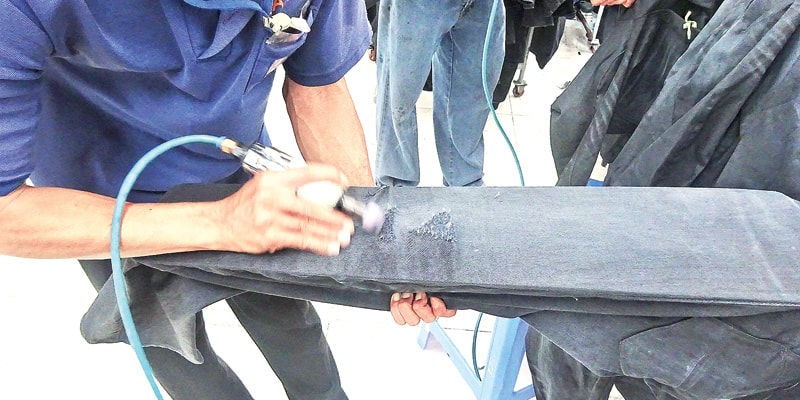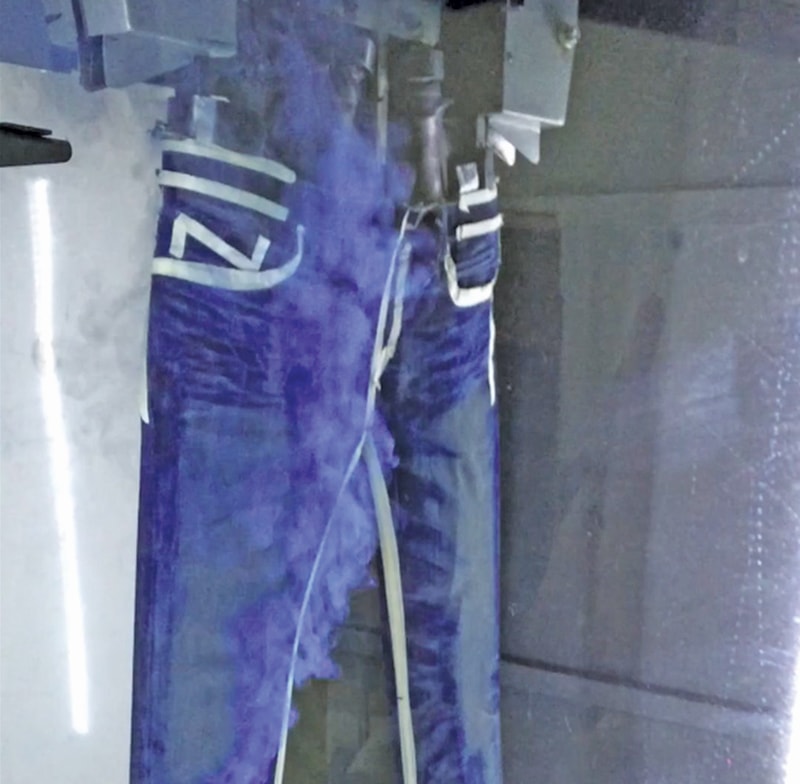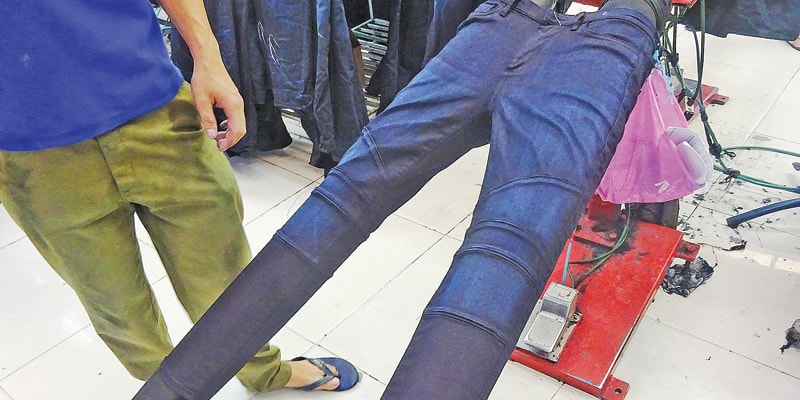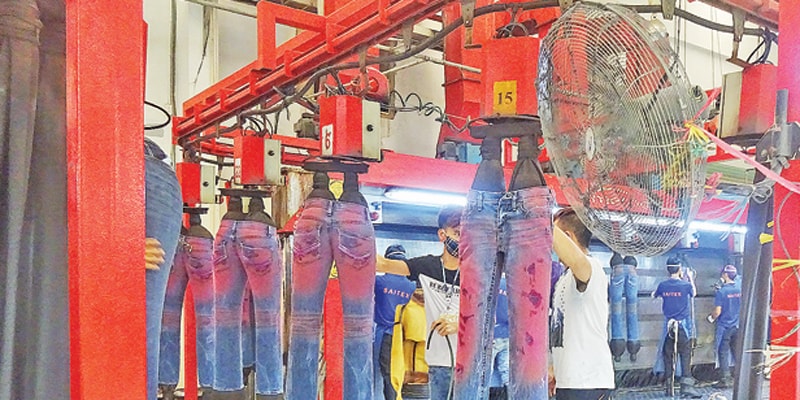
Adorning the clothes with a number of accessories and finishes not only intensifies its aesthetic appeal but also adds value to the garment. Be it eye-catchy print designs, attractive thread work, use of embellishments such as sequins, or various types of embroideries like flock printing, there is a compelling need among apparel manufacturers to differentiate their products from others by adding value to the garments. Jeans is mostly enhanced by various finishes, both dry finish and wet finish, to modify the appearance and comfortability of jeans. One such technology that is currently in use is laser finishing, usually known as denim fading technique. In this edition of Tech Value Addition comeback, Team StitchWorld discusses the various techniques of denim fading and advantages of laser finishing.
Grabbing eyeballs since the beginning, with its multi-faceted use from casual daily wear fabric to trendy high fashion garment, denim has the ability of fitting into any social or professional setting. Basic denims can take on new appeal with an innovative concoction of chemicals, scrappers, laser beams, pumice stones, etc. and there are various methods to achieve that natural faded streak in denim, which is much sought-after by masses and classes alike.
Team SW explores on how your favourite pair of denim jeans undergoes that ‘washed’ look and which conventional method various denim players in the industry acknowledge to achieve that finish…
Arvind Denim achieves denim fading look by manually scraping with emery paper of different grades and strokes depending on the intensity and look desired, or by using handheld rotary device with emery paper attached on the desired area with the required number of strokes. The company also does denim fading via laser by creating the desired area and burning them on the denim, along with robots to do the scraping part. Ashish Kumar, CEO, Arvind Exports states, “Levi’s, one of our customers, asks for denim fading by laser. It is a sustainable technology and the future of denim fading.”
Catering to Benetton Jeans, Spykar Jeans and Pepe Jeans, RC Apparels use conventional method of denim fading such as manual scraping by sandpaper. The process of fading of jeans at RC Apparels requires the air dummies onto which the jeans is fitted and the air is blown up. The company uses rubber templates of different sizes as reference areas where the fading effect is to be created. PP spraying on jeans is another technique used to create that effect. Manvendra Singh, GM – Operations, RC Apparels states, “Laser fading is still not popular in India due to its high investment.”
A well-known jeans manufacturer in Vietnam, Sai-Tex does various types of finishing on jeans including the fading effect. The company achieves the look by doing PP spray on jeans and then leaving it to dry. “From next year onwards we will start using an indigenously developed eco-friendly alternative to PP spray for G-Star products. G-Star is one of the most renowned buyers of the company,” mentions Md. Ifthikar, Production Director, Sai-Tex. Additionally, the company also uses the sustainable way of denim fading through the help of laser machines by Jeanologia.

Fading denims with laser technology…
The phase of fading of denim by sandblasting is losing its momentum as the new technology of laser finishing is coming into play. Also known as spray painting in denims, laser finishing is used exclusively on the surface of the denim and are considered a more sustainable process compared to other traditional methods of finishing such as acid washing, sandblasting or PP spray. In laser finishing, a computer inputted with design, drives the laser beam to the material where fading is required. The laser works by creating extensive heat. The laser beam decomposes the dye and the resulting vapours vent away. The material fades only where the beam impacts on the fabric. Commercially, two types of lasers are being used: solid-based (wavelength of 1 μm) and gas-based (wavelength of 10 μm). The desired degree of fading depends upon the wavelength, power density, and pulse width of the laser beam.
Advantages of laser finishing
This computer-controlled process of laser finishing uses zero water and therefore is an ecological and economical process. This technique can create not only local abrasion and fabric breaks, used look effect but also lines and/or dots, images, text or even pictures as well. It not only consumes less time and less space but also offers high consistency of production and excellent reproducibility and high productivity. Possibilities of human error are absent being an automatic system with 0 per cent rejection rate compared with around 5 per cent in manual system. The ratio of manpower required in laser and manual is approximately 1:3. Moreover, the effect quality and hand feel is comparatively finer in laser system as against manual denim fading. The machine is extremely safe, simple to operate and compact. It therefore necessitates very low maintenance and cleaning.
Disadvantages of laser finishing
The biggest setback of this technique is its relatively high cost. Skilled operators are required to handle the machine which proves out to be a hindrance at times. Also, power requirement is higher in laser system (approximately 7.5 kilowatt per hour). Creation of a natural looking effect on denim through laser finishing might be a problematic concern. The fumes produced during the process are hazardous to health and laser radiation has harmful effects on eyes and skin.
Machinery for laser finishing
Tonello’s new development multicolour Laser is capable of furnishing different colours on a denim (or any other fabric) substrate by homogeneously applying a resin (developed by Zaitex) onto the garments. The resin is then permanently imprinted on the fabric through a special setting of Tonello Laser.
Jeanologia, the Spanish innovator of denim finishing technologies, lays emphasis on sustainable denim finishing technologies with TwinHS – a machine utilizing laser light for the creating wash effects on denim. Equipped with two laser resonators of maximum power and designed for mass production volumes, TwinHS is touted to be amongst the most productive and fastest laser in the market with an output of 4,000 5-pocket jeans per operator per day. Each operation is controlled by an artificial vision camera so as to ensure no time is wasted on secondary operations and the operator can keep a tab on the progress of a design. The rotation speed of its dummy and its easy placement for the garment help speed up the process. Its dual marking system and an exclusive digital power control allow working on both jeans legs at the same time.
Jeanologia Flexi E laser technology incorporates the ultimate electronic features and Jeanologia’s patented technology UFS (Ultra-Fast Scan) that increases marking speed while reducing electrical consumption on each garment. Its reference element system offers easy garment placement. Rotating head and optical system that allow working either on horizontal or vertical mode can deliver multiple marking combinations.
In the realm of eco-sustainability, another company encouraging environment-friendly denim finishing practices is Sei Laser, the leading Italian manufacturer of industrial laser systems, with its Flexi Denim, a digital laser machine that replaces traditional, manual methods for discoloration, abrasion, decoration, marking, engraving and cutting of jeans and other finished garments. Flexi Denim safeguards the environment by reducing water consumption by 80 per cent and eliminating the use of toxic chemicals. It can be custom configured to meet the needs of customer at the time of purchase and upgradeable later with additional options. Jeans can be processed horizontally on the tables or vertically on the mannequin.
Jeans Laser Engraving Machine ZJ(3D)-9090LD by Golden Laser, equipped with 500W CO2 RF metal laser and triaxial dynamic large-format galvanometer control system, is an energy-saving, eco-friendly solution. This low-maintenance-cost machine can engrave a variety of personalized designs such as cat whiskers, monkey wash, PP spray, hanging rub, ripped, sandblasting, snow, portrait and other effects with clear texture and never fade.
Conventional Methods of Denim Fading
These conventional techniques largely fail on sustainability grounds and call for a more sustainable and environment-friendly option.

Whiskering
Whiskers, also known as cat’s whiskers, are the worn out lines and impression patterns generated by natural wearing on hips and front thigh area. This is being done manually with help of sharp edge emery paper rubbed on denim. DemcoVina mechanically scrapes the denim with sand paper on the areas to be faded. The areas to be faded are referenced by the templates under the denim, which serve as a guide for areas that must be scraped and abraded.
Grinding/Scraping
The ‘destructed’ denim look is most popular among teens and the youth. The certain look is achieved using blades and other rough or sharp tools to nick and tear denim surface at desired places.
Sandblasting
The technique, purely a mechanical and water-free process, is based on scrubbing of the garment by blowing high-speed air mixed with very fine particles of sand onto specific areas of the garment surface to be treated, to give the desired distressed/abraded/used look. Though it provides uniformity in natural abraded effect, it is a hazardous technique and has been banned.
Stone Washing
Freshly dyed jeans are loaded into large washing machines and tumbled with pumice stones to achieve a soft hand and desirable look. Pumice stones give the additional effect of a faded or worn look as it abrades the surface of the jeans removing some dye particles from the surfaces of the yarn. However, quality of the process is difficult to control as the outcome of a load of jeans is never uniform and requires high capital investment as well. It damages the machineries and garment due to stone to machine and machine to stone abrasion.
Tonello has designed NoStone® to overcome economic, mechanical and environmental limitations of existing stone-wash processes. The NoStone® system eliminates the use of pumice stone, replacing it with a stainless-steel abrasive drum, fastened to the washing machine. This drum can create a variety of finishes through flexible abrasion adjustments to create the look and styles. Due to the mechanical – rather than chemical – nature of the process, the NoStone® effect is the same as that of stone-wash and reduces the carbon footprint created by using pumice stones.

Potassium Permanganate Spray (PP Spray)
To achieve a bright effect on denim, PP Spray is done with the help of normal spray gun with each jean installed on rubber dummies. Garments are mounted on the dummies and air is filled so the full fit of the garment is exposed. The garment is hanged in the open to dry after PP Spray and it turns its colour completely to brown, followed by neutralization process to remove any chemicals which can oxidize or irritate the skin of the wearer and prevent yellowing and bad smell from garment. The most common neutralizer used is sodium metabisulfite (Na2S2O5) which is used as an antioxidant. This process is extremely dangerous to health as micro-particles absorbed by works performing this technique results in lung problems.
Another offering by Tonello to overcome harmful effects of PP Spray is The Water Brush that uses water for whitening. Interestingly, the Water Brush runs on water but consumes none as a large tank beneath the spray robot collects the water used for whitening the garment, filters it, and sends it back to the robot through a recirculation system. The highlight again is reduced consumption of resources, and zero impact on environment and operators.






